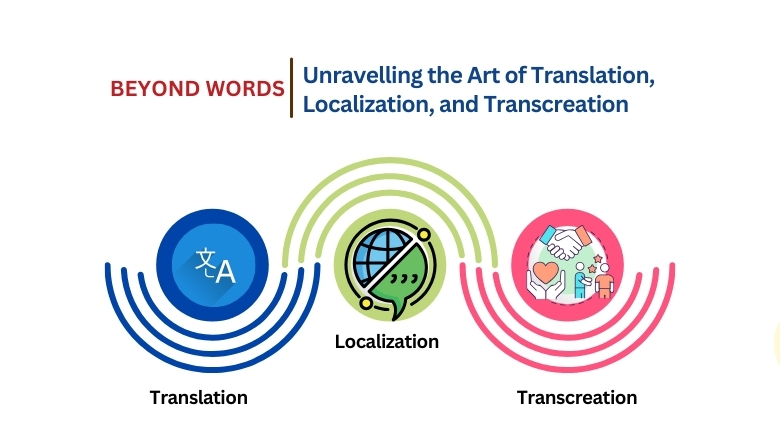
The majority of people are confused between the three words translation, localization, and transcreation. They classify these words under the same category, which means the same work happens under them. However, the story is different!
This blog will help you understand these words in a streamlined manner.
Understanding Translation: Word for Word, Across the World
Translation means changing text from one language to another while preserving the original meaning. This practice ensures that the content remains consistent across different languages. Translation and localization companies focus on linguistic accuracy, maintaining the structure of the original text. This approach is essential for technical documents, legal texts, and user manuals where precision is paramount.
In translation, each word is carefully chosen to match its counterpart in the target language. This meticulous process guarantees that the information conveyed is identical, regardless of the language barrier. However, while translation excels in accuracy, it may not always capture cultural nuances and emotional subtleties, which leads to the need for more adaptive approaches like localization and transcreation.
To ensure consistency and quality in translation, it is essential to have a well-defined framework. Creating a Style Guide for Translation can be invaluable in this process, providing guidelines that help translators maintain uniformity in terminology, tone, and style across all translated content.
Localization: Tailoring Text to Fit the Audience
Localization adapts the content to suit the cultural and regional preferences of the target audience. This process ensures that the text resonates with local customs, traditions, and societal norms. Furthermore, it also involves modifying various elements such as date formats, currencies, idiomatic expressions, and even color schemes to align with the local context.
For instance, a marketing campaign that works well in one country may require significant adjustments to be effective in another. Localization addresses these differences, ensuring that the message is understood and embraced by the local audience. This approach is essential for global businesses with a strong presence in diverse markets.
Best software localization services also encompass visual adjustment of multilingual texts. For example, right-to-left languages like Arabic require a different layout than left-to-right languages like English. Therefore, localizing a website involves redesigning the interface to ensure a seamless user experience.
Furthermore, it’s better to enhance localization skills to grow more in this industry. Therefore, learn more about them by clicking here.
Amplify Your Brand’s Global Reach
Choose Our Expert Translation, Localization, and Transcreation Services Today!
Transcreation: Creativity Meets Cultural Reality
Transcreation is a blend of translation and creative writing. It involves recreating content to evoke the same emotions and reactions in the target language as the original text. It is widely used in advertising, marketing, and branding, where the emotional impact of the message is important.
Furthermore, it focuses on accuracy and prioritizes the original content’s intent, style, and tone. The goal is to create a message that resonates deeply with the target audience. Transcreation allows for greater flexibility and creativity, adapting slogans, taglines, and marketing campaigns to suit different cultural contexts.
For example, a humorous advertisement in one country may fall flat in another due to cultural differences. Transcreation involves understanding these nuances and crafting a message that delivers the desired impact. This approach ensures that the essence of the original content is preserved while making it relatable to the new audience.
When to Use Translation, Localization, or Transcreation
Choosing between the three depends on the content’s nature and the communication’s goals. Here are some scenarios where each approach is most suitable:
- Translation: Best for legal documents, technical manuals, academic papers, and any content where accuracy and consistency are critical. This approach ensures that the information remains unchanged across different languages.
- Localization: Ideal for websites, video games, and any content that needs to align with local cultural and regional preferences. It ensures that the content is important and engaging for the target audience.
- Transcreation: Perfect for marketing materials, advertising campaigns, slogans, and branding efforts where the emotional and cultural resonance of the message is key. Transcreation allows for creative adaptation to ensure the message has the desired impact.
Concluding Words
Translation, localization, and transcreation are important; each plays a vital role in fulfilling language and cultural loopholes. Businesses can communicate their message to a global audience by understanding the differences and when to apply each approach. Embracing these strategies ensures that the content is accurate, relevant, and impactful for national and international audiences.







